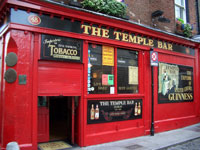Airport
Dublin Airport
IATA Code: DUBLocation: The airport is situated seven miles (11km) north of Dublin, near the M50 and M1 motorways.
Time: GMT (GMT +1 between the last Sunday in March and the Saturday before the last Sunday in October).
Contacts: Main number: +353 (0)1 814 1111. Car parking: +353 (0)1 814 4328.
Transfer to the city: Several bus services, involving more than 700 buses including Dublin Bus and Flybus, connect the airport to all parts of Dublin and the city's central train station, both day and night with fares starting at EUR6. Taxis are available outside the Arrivals Hall, the fare is best agreed in advance and should be around EUR20 to the city centre. There are car-hire desks in the Arrivals Concourse.
Taxis: Taxis are available in front of the Arrivals Hall and a taxi from Dublin Airport to the city centre costs about EUR20, and an extra charge for baggage may be added, as well as a surcharge in the evenings and on weekends. All taxis have meters but are only used for destinations in the 'Dublin City Taxi Metered Area'. It is wise to negotiate the price with the driver beforehand.
Car rental: Hertz, Avis, Budget, Murrays Europcar and National Car Rentals all operate from car-hire desks in the Arrivals Concourse. There are also a number of pre-booked car-hire desks on this concourse. These include Argus, Atlas. Dan Dooley, Hamills, Malones, Sixt and Thrifty.
Facilities: Airport facilities include a bureau de change and ATMs, numerous restaurants, pubs and bars, several shops, a church and tourist information. Disabled passengers are well catered for; travellers with special needs are advised to contact their airline in advance.
Parking: One short-term car park close to the terminal; one off-site long-term car park serviced by free shuttle service.
Departure tax:
Website: www.dublin-airport.com
Visit worldtravels.com for the full guide to Dublin. Build a complete Dublin travel guide and email to your clients - sign up for a trial subscription of World Travels Pro.
Dublin

Cosmopolitan, colourful and over a thousand years old, Dublin presents a fine starting point for visitors to Ireland. This capital city is split in two by the River Liffey, which gives form to the city and has no less than nine bridges spanning it. Easily explored on foot, central Dublin presents a wealth of historic landmarks, from ancient cathedrals to gracious Georgian buildings that pay testimony to days gone by. There are several attractions on both sides of the Liffey, ranging from gaols and castles to the birthplaces of famous poets and writers and guided literary trails.
Not far from the city in County Wicklow are the Wicklow Mountains, where hills and glens, forests and waterfalls attract weekend walkers and nature-lovers. Dublin Bay, which lies between the mouth of the River Liffey and the Dalkey headland, is the site of several small coastal towns and the ferry port of Dun Laoghaire. County Kildare is a region of rich farmland and fine reputation for the breeding of thoroughbred horses, while the similar counties of Louth and Meath have evidence of early civilisations and a wealth of castles and monasteries.







